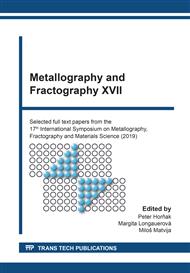p.66
p.75
p.80
p.86
p.92
p.100
p.109
p.115
p.121
Structural Nature of ZnAl4Cu1 Alloy Plasticity Affected by Various Technological Treatments
Abstract:
The aim of this work was to analyse the microstructural nature of plasticity in ZnAl4Cu1 alloy and its dependence on the processing technology. The alloy condition was analysed after gravity casting, after forging and after ECAP processing. Two alloys with slightly different compositions were studied. For alloy A, the returnable material from a prominent Zn alloy producer was used. For B alloy input raw materials of relatively high purity were used. Tensile testing showed that in the as-cast alloy tensile strength had relatively low levels up to 211 MPa, and particularly low values of ductility only up to 2.5 % were found in B alloy, which was more polluted. By means of ECAP processing of the as-cast alloy, the tensile strength was improved by 50 % (Rm = 312 MPa). In the case of the purer A alloy the majority of samples improved to level A = 27.9 %. Forging of the as-cast alloy preserved strength on a level similar to the ECAP result, but ductility was improved to the level of 34.4 %, although alloy B had lower purity. Further significant ductility improvement was obtained through ECAP processing to A = 147 % of the as-forged alloy. The microstructure of ZnAl4Cu1 consists primarily of segregated η phase (rich in Zn) and fine eutectoid composed of η and alpha phases segregated mostly in dispersive state, but in places also in lamellar form. Close correlation between microstructure and processing method resulted from our fractographic study. In the case of ECAP processing of the forged state the finest microstructure was achieved, which was accompanied by higher plasticity and also by fine dimples of transcrystalline ductile fracture (DTDF).
Info:
Periodical:
Pages:
92-99
Citation:
Online since:
November 2020
Keywords:
Price:
Сopyright:
© 2020 Trans Tech Publications Ltd. All Rights Reserved
Share:
Citation:


